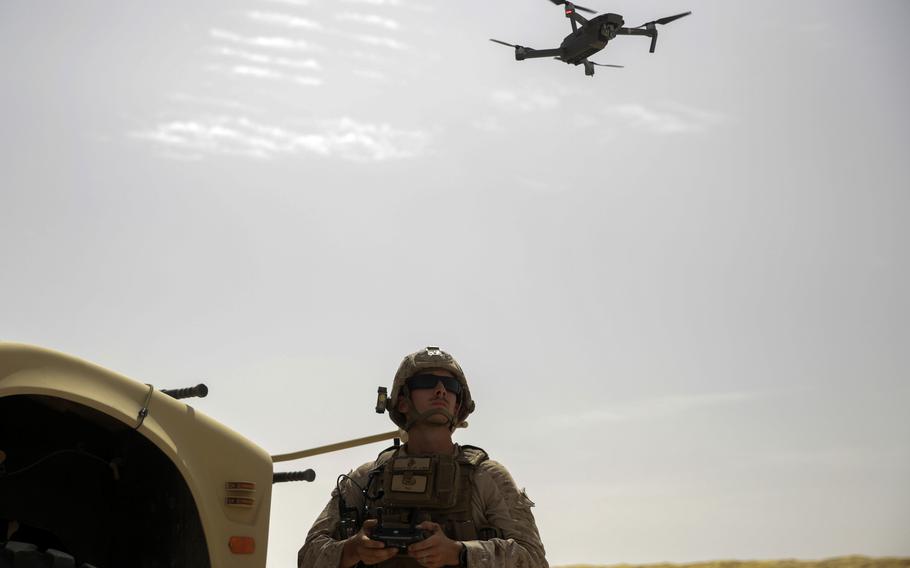
A Marine flies a DJI Mavic Pro drone while deployed to the Middle East in 2017. The U.S. Army needs to get small, off-the-shelf drones to troops in the field and let them experiment, a March 6, 2024, report by the Modern War Institute at West Point argues. (Shellie Hall/U.S. Marine Corps)
Ukrainians ‘shocked’ by lack of drone knowledge from U.S. trainers
Army procurement process ‘glacial,’ author says
They’re cheap enough for junior soldiers to destroy while trying them out, report says
STUTTGART, Germany — The U.S. needs to get small, off-the-shelf drones immediately into the hands of junior soldiers, who are getting left behind by a lethargic military bureaucracy and playing catch-up with their Russian counterparts, a new report argues.
During the Kremlin’s two years of fighting in Ukraine, Russia has gotten a jump-start on the U.S. and allies in buying, manufacturing and fielding small unmanned systems for ground combat, according to the Wednesday report by the Modern War Institute at West Point.
The Army “fancies itself an innovative organization,” but China and Russia “are surging ahead in the realm of (small drones) while the United States moves at a relatively glacial pace,” said the report, which was authored by Tyler Hacker, a former Army artillery officer and current researcher at the Center for Strategic and Budgetary Assessments in Washington.
Ukrainian troops trained by Americans were shocked by the U.S. soldiers’ general ignorance of drone warfare tactics, the report noted.
The criticisms, which circulated on social media last summer, related to training the Ukrainians received from the U.S Army in Germany.
“The Americans have not participated in a serious war for a while now. Their army does not even have an analogue of the Chinese Mavik 3 (small drone), it was a shock for us,” wrote one soldier on X, who added that the use of such systems seemed absent from U.S. planning.
The U.S. knows how drones are transforming the battlefield, but it is moving too slowly to adapt and lacks a realistic plan to produce cheap, disposable drones at scale, according to the report.
“One could identify myriad reasons for American and European sluggishness, but given the availability of drones on the commercial market, institutional inertia and military bureaucracy no doubt play a role,” it said.
Arguably the Army’s greatest asset, junior leaders working in platoons, are stymied by “archaic procurement processes and risk-averse regulation,” according to the report.
Over the past couple of years, the Army has taken steps to get up to speed, such as setting up a drone warfare school and instituting procurement efforts to develop small unnamed systems and counter-drone technology.
But not enough attention has been given to how soldiers can go on the offensive with small drones at the unit level, the report contends, adding that the service should consider outfitting formations with affordable commercial drones so units can try using the devices in new ways.
That would mean supplying them in large quantities to units at the platoon and squad level, bypassing the usual cumbersome top-down procurement approach.
From there, soldiers would experiment in the field and develop standard operating procedures while the Army addresses procurement.
“These inexpensive drones need not do everything or satisfy traditional Army requirements,” the report said.
To be effective, though, the service would have to accept that the drones are expendable and therefore wouldn’t hold it against soldiers if the devices were destroyed in training, Hacker said in the report.
Furthermore, the training should be carried out in realistic settings, with an array of weather conditions and in the face of indirect fire, he argued.
“The Army cannot afford to slow roll innovation in the time before it goes to battle with an adversary who has been refining its (small unmanned aerial systems) capabilities for years,” the report concluded.